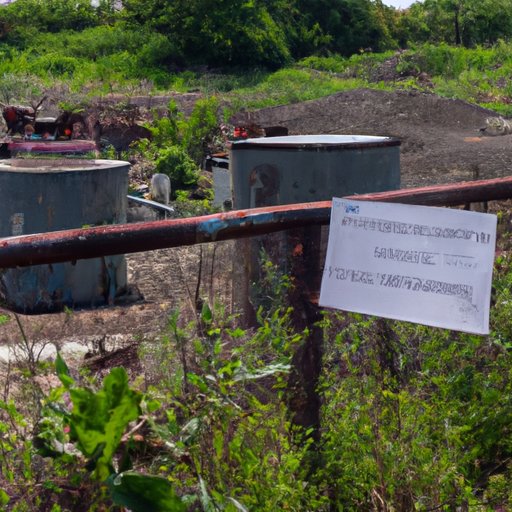Introduction
Superfund sites are areas designated by the Environmental Protection Agency (EPA) due to the presence or potential presence of hazardous substances that pose a threat to public health and the environment. These sites are often the product of industrial practices and neglect. The purpose of this article is to provide an in-depth understanding of Superfund sites and their history, hazards, remediation, and implications, as well as examining the issue of environmental justice as it pertains to these sites.
The History and Evolution of Superfund Sites: What You Need to Know
The concept of Superfund sites emerged in 1980 with the passing of the Comprehensive Environmental Response, Compensation, and Liability Act (CERCLA). This law was enacted with the goal of providing prompt and effective responses to hazardous waste emergencies and ensuring that polluters are held accountable for the damage they cause. The 1976 Resource Conservation and Recovery Act (RCRA) also played a key role in regulating the management of hazardous waste.
The EPA is responsible for identifying, investigating, and cleaning up Superfund sites. This process involves allocating funds, overseeing site investigations, identifying responsible parties, and developing and implementing cleanup plans. There are currently over 1,300 Superfund sites located throughout the United States, with varying degrees of contamination and urgency. The EPA prioritizes sites based on their level of risk to human health and the environment.
The history of Superfund sites is marked by several major incidents and disasters, such as Love Canal in New York and the Exxon Valdez oil spill in Alaska. These events not only highlighted the urgent need for stricter regulations and cleanup efforts but also brought attention to the disproportionate impact of environmental hazards on marginalized communities.
The Hazards of Superfund Sites: Why They Still Pose a Threat to Communities
Superfund sites can contain a multitude of hazardous substances, such as toxic chemicals, heavy metals, and hazardous waste, which can leach into the air, water, and soil. Exposure to these contaminants can lead to a variety of health effects, ranging from respiratory issues and skin irritation to cancer and birth defects. Vulnerable populations, such as children, pregnant women, and low-income communities, are often disproportionately affected by Superfund sites due to their proximity and lack of resources.
Case studies and ongoing impacts of Superfund sites illustrate the severity and long-term consequences of these hazards. For example, the Flint water crisis in Michigan brought attention to the dangers of high levels of lead in drinking water, which can cause irreversible neurological damage in children. Additionally, the effects of Hurricane Katrina in New Orleans were exacerbated by the presence of several Superfund sites, which released toxic chemicals and waste into the surrounding areas.
Remediating Superfund Sites: Current Technologies and Methods
The process of remediation involves identifying, evaluating, and mitigating the hazards posed by Superfund sites. There are several approaches to remediation, such as containment, treatment, disposal, and natural attenuation. Successful examples of cleanup efforts include the Hudson River and the Gowanus Canal in New York City, which used a combination of dredging, capping, and water treatment to reduce contamination levels.
Remediation efforts often face challenges and limitations, such as the complexity and extent of contamination, disagreement between stakeholders, and the high cost of cleanup. However, emerging technologies and innovations offer potential solutions to these obstacles, such as bioremediation, nanotechnology, and artificial intelligence.
The Financial and Legal Implications of Superfund Site Cleanups
The costs of Superfund site cleanups are substantial, with estimates ranging from millions to billions of dollars per site. Funding sources include taxpayer money, settlements with responsible parties, and contributions from industries and corporations. The benefits of Superfund site cleanups often extend beyond the immediate removal of hazardous waste, such as increased property value, job creation, and improved public health.
The EPA has legal authority to hold responsible parties accountable for the damage they cause and enforce compliance with cleanup plans. However, the process of liability and enforcement can be complicated, involving multiple parties and legal proceedings. Effective stakeholder engagement and community involvement in the remediation process are crucial for ensuring accountability and transparency.
Superfund Sites and Environmental Justice: Examining Disparities in Cleanup Efforts
Environmental justice is the principle that all people have the right to a healthy and clean environment, regardless of their race, income, or geography. However, studies have shown that low-income and communities of color are often disproportionately impacted by hazardous waste sites and receive unequal access to resources and information for cleanup efforts. This disparity is known as environmental racism.
Several grassroots and advocacy efforts have emerged to address this issue, such as the Environmental Justice League of Rhode Island and the Gulf Coast Fund for Community Renewal and Ecological Health. These organizations aim to empower communities and advocate for policies that prioritize the health and well-being of marginalized groups.
Conclusion
In conclusion, Superfund sites remain a significant threat to public health and the environment, and their remediation requires innovative technologies, responsible parties to be held accountable, effective stakeholder engagement, and consideration of environmental justice principles. It is essential that we continue to raise awareness and advocate for equitable and sustainable solutions to address this important issue. We must ensure that the legacy of hazardous waste and pollution does not continue to harm future generations.
